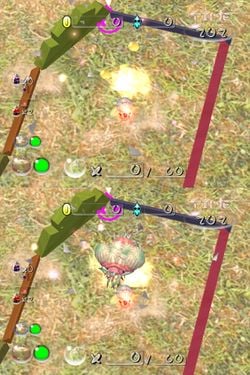Randomization: Difference between revisions
Jump to navigation
Jump to search
(Added some more, and cleaned up.) |
Greenpickle (talk | contribs) (replace number generation section with external link) |
||
| Line 6: | Line 6: | ||
'''Randomness''' is the concept of unpredictable outcomes for events. Whenever an aspect of a [[Pikmin series|''Pikmin'' game]] can have multiple outcomes which are not determined by anything controllable, the result is randomly picked. | '''Randomness''' is the concept of unpredictable outcomes for events. Whenever an aspect of a [[Pikmin series|''Pikmin'' game]] can have multiple outcomes which are not determined by anything controllable, the result is randomly picked. | ||
[[File:Egg frames.jpg|thumb|right|250px|The result of [[Olimar]] breaking an [[egg]] on a certain frame (top), and on the frame immediately after (bottom).]] | [[File:Egg frames.jpg|thumb|right|250px|The result of [[Olimar]] breaking an [[egg]] on a certain frame (top), and on the frame immediately after (bottom).]] | ||
==List of random elements== | ==List of random elements== | ||
| Line 67: | Line 61: | ||
==See also== | ==See also== | ||
*[[Challenge run]] | *[[Challenge run]] | ||
==External links== | |||
*[[wikipedia:Random number generation|Random number generation]] article on Wikipedia | |||
[[Category:Technical]] | [[Category:Technical]] | ||
[[Category:Gameplay]] | [[Category:Gameplay]] | ||
Revision as of 17:26, September 29, 2014
|
The following article or section is in need of assistance from someone who plays Pikmin 3. |
|
This article or section is in need of more images. |
Randomness is the concept of unpredictable outcomes for events. Whenever an aspect of a Pikmin game can have multiple outcomes which are not determined by anything controllable, the result is randomly picked.
List of random elements
The following is a list of notable elements in the series that have a randomly picked result.
General
|
To do: Can Snagrets get stuck in Pikmin 3? |
- Gameplay mechanics
- Pikmin who are knocked down in battle have a chance of losing their bud or flower, and reverting to a leaf.
- When a carrying destination tie takes place, the final destination is randomly picked.
- The amount of nectar contained in a patch of nectar weed and rubble.
- The chance for a Pikmin to trip while walking. This chance is much lower in Pikmin 2, and tripping is absent in Pikmin 3.
- Enemies
- For some enemies that drop pellets when defeated, the pellets' types are randomly picked between the available types.
- The chance of a Burrowing Snagret or Pileated Snagret to get stuck while emerging.
- The idle time, move time and angle change for the Iridescent Flint and Glint Beetles, as well as the Doodlebug, is random.
- The chance of a Swooping Snitchbug idling in place, swooping, or throwing is random.
- Aesthetic
- The sounds Pikmin make during various events, like being plucked, is randomly chosen from a selection.
- The leader(s) and Pikmin's idle animations are randomly picked from a list.
Pikmin
- The sound that plays on the Nintendo logo screen is randomly picked; the chances of hearing one of the Easter eggs sounds is quite low.
- The attacks chosen by the Emperor Bulblax when at less than half health are randomly picked.
Pikmin 2
- Aesthetic
- The animation the Pikmin do on the Nintendo logo screen is randomly picked.
- The season picked for the title screen is random, as well as the behavior of the creatures that roam on the floor.
- Gameplay mechanics
- The generation of cave sublevels is done by randomly picking the cave units that make up the sublevel.
- The power obtained from the roulette wheel in 2-Player Battle is chosen at random.
- The contents of eggs and petrified corpses is randomly chosen the exact moment the contents have to be expelled.
- Purple Pikmin have a 30% chance of stunning most enemies; a few enemies have different chances.
- 2-Player Battle:
- The advisory given at the start of a match is randomly picked.
- Most levels have specific layouts, but the layout that gets picked is randomly chosen.
- The location cherries spawn at is randomly picked from a list.
- Enemies
- Gatling Groink shots are deviated by a random amount.
- The placement of the boulders that drop in Empress Bulblax and Segmented Crawbster fights is random, but centered around the active leader.
- The Titan Dweevil picks the weapon to attack with at random, from the ones it has. In addition, the location of the electrical nodes when using the Shock Therapist is random.
- The types of Unmarked Spectralids that spawn are randomly picked, but with specific chances.
- Wogpoles and Dweevils run in more or less random directions, but generally away from leaders.
- The number of shots fired by the Man-at-Legs, as well as its movement, is random.
- Mitites scuttle around in random directions.
- The chance of an Ujadani attacking with poison is random, but considerably low.
See also
External links
- Random number generation article on Wikipedia
